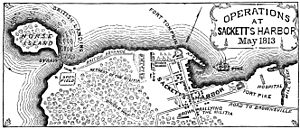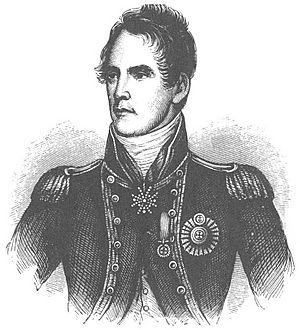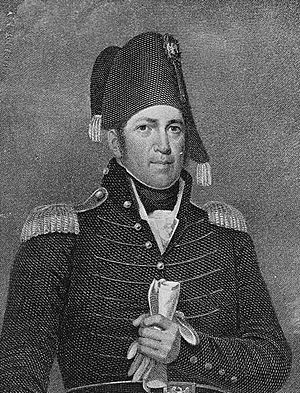Second Battle of Sacket's Harbor facts for kids
Quick facts for kids Second Battle of Sacket's Harbor |
|||||||
|---|---|---|---|---|---|---|---|
| Part of The War of 1812 | |||||||
 Plan of the Battle of Sackett's Harbor, from Benson J. Lossing's Field Book of the War of 1812 |
|||||||
|
|||||||
| Belligerents | |||||||
| Commanders and leaders | |||||||
| Strength | |||||||
| Land: ~500 regulars, ~900 militia, 2 field guns, 2 forts Sea: 2 schooners Total: 1,400 |
Land: ~870 infantry, 2 field guns Sea: 3 sloops-of-war 2 brigs-of-war 1 schooner |
||||||
| Casualties and losses | |||||||
| 153 killed and wounded 154 captured 3 guns captured Total: 307 |
230 killed and wounded 35 wounded prisoners Unknown number of warships damaged Total: 265 |
||||||
The Second Battle of Sacket's Harbor happened on May 29, 1813, during the War of 1812. A British force crossed Lake Ontario to try and capture Sacket's Harbor. This town was a very important place for the American navy. It was their main shipyard and base on the lake. The British wanted to take it because many warships were built there. However, American soldiers, local fighters (militia), and sailors successfully defended the town.
Contents
Why This Battle Happened
In the beginning of the War of 1812, the British controlled the Great Lakes. But in September 1812, Captain Isaac Chauncey of the U.S. Navy was told to take control of the lakes. He quickly brought many shipbuilders, sailors, and cannons to Sacket's Harbor. This helped build a strong American navy there.
By early 1813, the main American forces were at Sacket's Harbor. Captain Chauncey's navy was stronger than the British navy at Kingston. The American army also had more soldiers than the British. They could have attacked Kingston, which would have greatly hurt the British.
However, the American leaders, Major General Henry Dearborn and Captain Chauncey, thought the British had more soldiers at Kingston than they actually did. So, they decided to attack York instead. York was the capital of Upper Canada. On April 27, the Americans won the Battle of York. They took over the town for a short time and then moved to Fort Niagara. They planned to attack Fort George next.
Meanwhile, Captain James Lucas Yeo was put in charge of the British navy on the Great Lakes. He arrived in Kingston on May 15, 1813. He joined Governor General Sir George Prevost, who was the leader of Canada. They worked to finish building a new British warship called the Wolfe. They knew that once the Wolfe was ready, their navy would be stronger than the American one. But they also knew the Americans were building a powerful new ship, the General Pike, at Sacket's Harbor. This ship would give the Americans the advantage again.
On May 25, the American navy was seen near Fort George. The British commander there sent a message to Kingston. When Prevost and Yeo heard this, they realized the American navy and army would be busy at Fort George for a few days. This was their chance to attack Sacket's Harbor. They hoped to destroy the shipyard and gain control of the lake.
The Battle Begins
British Attackers
The British quickly gathered their soldiers at Kingston. These included different groups like the 100th Regiment and the Canadian Voltigeurs. They also had two cannons. Since no other general was available, Governor General Prevost himself led the attack. He put Colonel Edward Baynes in charge of the soldiers once they landed.
The British force left on May 27 and arrived near Sacket's Harbor the next morning. The wind was very light, making it hard for the ships to get close to shore. The attack was called off when unknown ships were seen in the distance. These turned out to be American boats carrying more soldiers to Sacket's Harbor.
Fight at Henderson Bay
The British sent out canoes with Native American warriors and a gunboat to stop these American boats. The British caught up with the American convoy near Stoney Point. When the British started firing, the American soldiers, who were mostly new recruits, jumped out of their boats and ran into the woods. The Native Americans chased them. After about 30 minutes, the American soldiers surrendered. They lost 35 men, and 115 were captured. Only seven Americans escaped and reached Sacket's Harbor.
American Defenders
This delay gave the Americans more time to get ready. About 400 regular soldiers were at Sacket's Harbor. They were in forts and other small groups. Lieutenant Colonel Electus Backus was the highest-ranking regular officer. There were also 250 local volunteers and 500 more local fighters (militia) who quickly joined. Brigadier General Jacob Brown of the New York militia took command of all the American troops.
The Americans had built strong defenses, including forts and blockhouses. They also had earthworks and barriers made of felled trees around the town and shipyard. These defenses were planned by Lieutenant Colonel Alexander Macomb.
Most of the American navy was with Captain Chauncey at Fort George. But two armed ships, the Fair American and the Pert, were at Sacket's Harbor. Lieutenant Woolcott Chauncey, Captain Chauncey's younger brother, was the senior naval officer there.
British Attack on Sacket's Harbor
On the morning of May 29, Prevost started the attack again. British soldiers landed on Horse Island, south of the town. They faced fire from American cannons and muskets. The British lost some men but landed successfully. The American volunteers defending the island then pulled back.
The British then charged across a flooded path connecting the island to the shore. The American militia here ran away, leaving their cannons. General Brown managed to gather about 100 of them.
The British tried to attack the town and shipyard from the land side. But the American regular soldiers fought back slowly, falling back behind their strong defenses. They stopped every British attempt to break through their forts.
Captain Yeo had gone ashore with the troops, so his larger ships did not get close enough to help the attack. The smaller British gunboats could get close but had weak cannons that couldn't damage the American defenses. Finally, one British ship, the Beresford, used long oars to get closer. Its cannons quickly forced the American artillerymen out of Fort Tompkins.
Some of the Beresford's shots went over the fort and landed near the shipyard. A young American naval officer, Acting Lieutenant John Drury, mistakenly thought the fort had surrendered. He ordered the new warship General Pike, which was still being built, and many supplies to be set on fire.
At this point, Prevost believed they could not win. His own cannons were not used, so he couldn't break the American defenses. Also, the American militia that General Brown had gathered were attacking his soldiers from the side and behind. Prevost ordered a retreat. He later said the enemy was defeated and the retreat was orderly. But other British soldiers said the retreat was messy, and everyone blamed each other.
The Americans said that if Prevost had not retreated so quickly, he might not have made it back to Kingston. American soldiers from the 9th Infantry were marching to the battle, but the British left before they arrived.
Who Was Hurt?
The British lost 49 soldiers killed and 216 wounded. Sixteen of these wounded were left behind. This includes 35 wounded prisoners. So, the total British loss was about 30 killed, 200 wounded, and 35 wounded prisoners. A notable British officer, Captain Andrew Gray, was killed.
The Americans lost 22 killed, 84 wounded, and 26 missing from their regular and volunteer troops. The militia lost about 25 men. This means about 157 Americans were killed, wounded, or missing in the battle on May 29. Lieutenant Colonel Electus Backus was among those killed.
If we include the 35 men killed and 115 captured at Henderson Bay on May 28, the total American loss was 307 soldiers killed, wounded, or captured. The British captured three cannons and 154 prisoners in total.
What Happened Next?
Even though the General Pike was set on fire, it was built from green wood and didn't burn well. The Americans were able to save the ship. However, the fires destroyed a lot of valuable supplies, which caused problems later. Another ship, the Duke of Gloucester, was also destroyed, but it was already in bad shape.
News of the British attack made Captain Chauncey bring his entire navy back to Sacket's Harbor. He waited until the General Pike was finished. This left the American army on the Niagara peninsula without naval support. The British then attacked the American army, capturing supplies and forcing them to retreat.
Captain Yeo tried again to destroy the General Pike after it was launched but still being fitted out. He planned a surprise attack on July 1, but it got light too early, and his force had to hide. Some of his sailors left, and Yeo called off the attack, fearing the Americans had been warned.
For several months, the fighting on Lake Ontario was stuck. Then, on September 28, the General Pike badly damaged Yeo's main ship, the Wolfe. Yeo retreated, and the Americans controlled the lake for the rest of the year.
General Jacob Brown was rewarded for his victory at Sacket's Harbor. He became a Brigadier General in the United States Army. For the British, Governor General Prevost's reputation was hurt by the defeat.
Images for kids
Protecting the Battlefield
The American Battlefield Trust and its partners have worked to save and protect 25 acres of the Sacket's Harbor battlefield.






